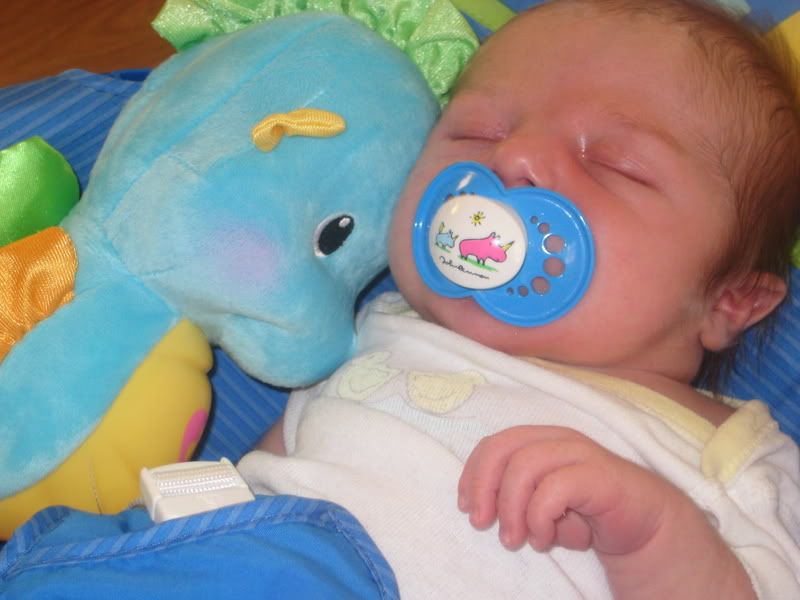This past week, Jonah went to see the doctor for the fourth time in a month. The last time that I posted about a doctor's visit, it was because Jonah had broken out in hives, thought to be caused by an ear infection. After we treated the ear infection, the hives persisted. They had begun to appear on his face. And so, we went back to the doctor a week later, and then we bumped his fifteen month check up to a week earlier as well. The doctor prescribed Zertec, because Benadryl did not seem to do anything for the hives at all. She told us that she hated to subject Jonah to yet even more needles and tests, but if the hives did not go away within two weeks she would refer us to an allergist to have tests done. In the meantime, we were to cut out dairy completely.
We cut out dairy from Jonah's diet, which was difficult since sometimes the only things he will eat are cheese or yogurt! But even with a strict dairy free diet and the new allergy medicine, the hives kept spreading. I was at my wit's end. He had been having these hives pretty much since Halloween. Finally, Daryl's mom had a revelation. She had just had the carpets cleaned Halloween weekend. I thought she had them steam cleaned, so I was happy to give her permission to get the carpets in Jonah's bedroom and play area cleaned. We have a lot of pets in our home, so I really welcomed having the dirt and dander removed. However, it came to the surface that the carpets were not steam cleaned, but a cleaning solution was used on them.
We put rugs down where we could, and kept Jonah off the carpets. Miraculously, the hives went away. It was the cleaning solution that was causing the hives. This is one reason that I prefer natural cleaning methods such as steaming or using naturally made cleaning products. I just recently bought a book that has several natural cleaning remedies, including herbal and natural carpet cleaning solutions:

I've already used some of the all-purpose cleaner "recipes" and have been very happy. I think the next time that we decide the carpets need a cleaning, we will try one of the solutions from this book as well.
So this past week, we had the follow up appointment with the doctor. Sadly, the hives were not the only item that we were following up on. At the 15 month appointment, we discussed Jonah's cognitive development. I've been concerned about his development for quite a while now, but that little voice that says every child develops differently kept pushing me to wait and see how he does. While I agree very strongly that every child is different, I also believe in mommy instincts. If Mommy feels that there is something going on with her child, most often she is right in my opinion. When I felt that Jonah was too small and too skinny, everyone told me that all babies grow differently, and he is just the right size for Jonah. It turned out, he was *not* just the right size for Jonah, and there was indeed something very very wrong. Had our current pediatrician not listened to my mommy instinct, I get chills at thinking about what might have happened to our beloved little boy.
And so I've had kind of the same feeling about his development, really since about June. It's not even that he's meeting milestones later than most children in his age (he's coming pretty close to the 1%ile in both speech as well as gross motor skills)but it seems to take him a lot longer to get from one step to another. For example, going back through my facebook notes, I realized that I had posted in September that he was letting go of objects and standing on his own for a few seconds. I exclaimed in these posts "We'll be walking by Halloween!" It is just my experience and observations that when a child begins to stand on his own, it is only a matter of weeks before the first steps are taken. Jonah did not take his first steps until mid-november. Again from my experience and observations, it usually only takes a child a week or so to go from taking a few unsure steps, to walking in order to get to places or objects across the room. Jonah is still only taking two or three steps at a time. He has ben taking two or three steps for about a month now. I know he will walk eventually, I am not worried about that. I am worried that it seems to be taking him much longer than other children to "get" things.
He is also gradually moving from "slightly delayed" to "moderately delayed" in speech. At sixteen months, though he knows and uses fifteen ASL signs, he relies on only a handful of phonemes. Dadada, Mamama, and jeejeejee. He doesn't use these phonemes to refer to anything, he only babbles them. I have never heard him use the ba or ga or ka or la phonemes, all of which he should have mastered by now. I notice this the most, of course, because of my intense studies and interest in speech development and acquisition. He very obviously understands language, because he uses sign language to refer to objects, actions, and people. There is just something about producing the words that he isn't picking up on.
Other things that Jonah cannot do that are of concern to me and the doctor are: stacking three blocks (he lines them up in perfect rows, but will not stack them) scribbling with crayons when shown, looking at me or Daryl if someone says "where is Mommy?" or "Where's Daddy?" pointing to body parts, looking for an object after it rolls behind a screen (most babies will look to the other side of the screen to see the object roll out, by nine months) and grasping items such as a spoon. These are just small flags though, the walking and talking is what really has us concerned.
Also, although I am well aware of the ultimate mommy-rule "do not compare thy baby to thy neighbor's baby," I can't help but notice that when we go to music class or play group, that Jonah is just... well, different. Seeing him alongside of these other children his age, or even his cousin who is three months younger than him, I can really see that he cannot do what they are doing. The differences are enough to make me cry some weeks at our music class.
These are not things that Jonah has not been exposed to. I have worked with him for a long time on all of them, knowing that they are important developmental milestones. I am afraid that last winter, when he stopped growing, his development was slowed. The doctor referred us to a specialist who will come to our home to do a full assessment. While part of me feels that she will not be able to tell me something I don't know, I also am glad to have someone who is coming at this with fresh eyes. Depending on what she says, we may have to go to occupational therapy with Jonah. Perhaps I am over-reacting, but if there is a problem with his cognition, it is much easier to get him back on track than it will be later in life. Perhaps it will all play out on its own, but if he needs help now then we will do what he needs.
 On Christmas Eve, it is a tradition in Daryl's family to go to dinner at the Toledo Club. The dinner is pretty formal, and so every family stops to get a picture taken in front of the main Christmas tree while they are wearing their dressy clothes.
On Christmas Eve, it is a tradition in Daryl's family to go to dinner at the Toledo Club. The dinner is pretty formal, and so every family stops to get a picture taken in front of the main Christmas tree while they are wearing their dressy clothes. When we got home, we took some portraits of Jonah in front of the tree, and read "How the Grinch Stole Christmas" before bedtime. Jonah got to open up his special "Christmas Eve" pajamas, and we took a couple pictures, but he didn't actually get to sleep in them because we've been having bed-wetting issues. We changed him back into them when he woke up in the AM, needing a fresh pair of jammies on. We are still trying to figure out why we are having this backslide in pottying. He was waking up completely dry.
When we got home, we took some portraits of Jonah in front of the tree, and read "How the Grinch Stole Christmas" before bedtime. Jonah got to open up his special "Christmas Eve" pajamas, and we took a couple pictures, but he didn't actually get to sleep in them because we've been having bed-wetting issues. We changed him back into them when he woke up in the AM, needing a fresh pair of jammies on. We are still trying to figure out why we are having this backslide in pottying. He was waking up completely dry.

 I am going to save Christmas Morning for another blog post, because I have a bit more than a paragraph to say about it. So I will just skip ahead to the day after Christmas. We went to the Toledo Zoo for their "Lights Before Christmas" display. Nevermind that we went "after" christmas, I never really liked the name of the lights display, but it really is a fun thing to go and see. Jonah absolutely loves it. We happened to pick the warmest night of the week. All of the snow had melted that day, and we were able to enjoy being outside rather than freezing. Later that night, the temperatures dropped and it began snowing again, so we were really lucky that we had gone during that window of warmth!
I am going to save Christmas Morning for another blog post, because I have a bit more than a paragraph to say about it. So I will just skip ahead to the day after Christmas. We went to the Toledo Zoo for their "Lights Before Christmas" display. Nevermind that we went "after" christmas, I never really liked the name of the lights display, but it really is a fun thing to go and see. Jonah absolutely loves it. We happened to pick the warmest night of the week. All of the snow had melted that day, and we were able to enjoy being outside rather than freezing. Later that night, the temperatures dropped and it began snowing again, so we were really lucky that we had gone during that window of warmth!









 ng in the "new" bed! It's the best that I could get, because Jonah was very eager to explore his new bed.
ng in the "new" bed! It's the best that I could get, because Jonah was very eager to explore his new bed.








